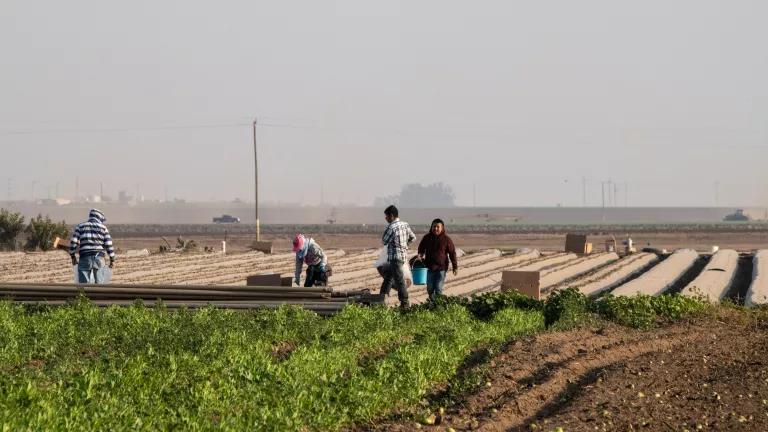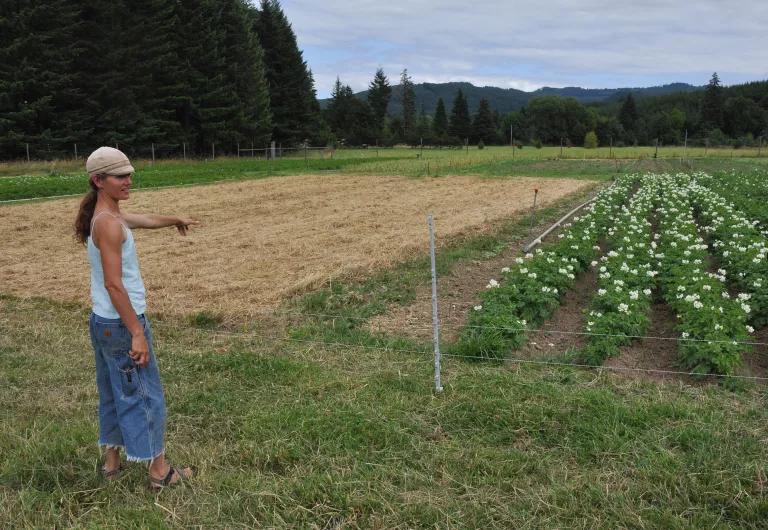Organic Agriculture Helps Solve Climate Change
As farmers grapple with everything from extreme weather events to heat stress to wildfires, and agriculture becomes less predictable in the face of a changing climate, it is essential for governments to help farmers transition to practices that increase resilience and dramatically decrease reliance on fossil-fuel based chemicals.

New and beginning farmers on the 100-acre Agricultural Land Based Training Association (ALBA) organic farm in Salinas, CA
USDA Photo by Lance Cheung
For the past year, the California Air Resources Board (CARB) has been developing its 2022 Draft Climate Change Scoping Plan, intended to carve out a path to carbon neutrality for California by mid-century. After months of advocacy from NRDC and its allies calling on CARB to include incentives for organic farming as well as pesticide use reduction in the Natural Working Lands section, the agency released its proposed approach in May. In this draft, the agency recommends converting 20% of California’s agricultural lands to organic agriculture by 2045 as a way to mitigate climate change. While this recommendation is not nearly ambitious enough (California’s organic acreage grew by 44% from 2014 to 2019 according to a report from the state’s Department of Agriculture), it is nonetheless an important milestone because it recognizes and affirms the essential role that organic farming systems can play in climate-smart agriculture.
Organic agriculture is an important lever in moving the needle on climate change. Here’s why:
Organic Farming Reduces Greenhouse Gases
Because fossil fuel-based fertilizers and most synthetic pesticides are prohibited in organic farming, it has a significantly lower carbon footprint. The production of these farm chemicals are energy intensive. Studies show that the elimination of synthetic nitrogen fertilizers alone, as is required in organic systems, could lower direct global agricultural greenhouse gas emissions by about 20%. A forty-year study conducted by the Rodale Institute also showed that organic farms use 45% less energy compared to conventional farms (while maintaining or even exceeding yields after a 5-year transition period.) Meanwhile, fumigant pesticides - commonly used on crops like strawberries and injected into soil - emit nitrous oxide (N2O), the most potent greenhouse gas. Research indicates that one commonly used fumigant pesticides, chloropicrin, can increase N2O emissions by 700-800%. Two other fumigants (metam sodium and dazomet) are also known to significantly increase N2O output.
Organic Farming Improves Soil Carbon Sequestration

Beth Hoinacki shows an aspect of her crop rotation and cover crop plan on the certified organic Goodfoot Farm, Philomath, OR.
U.S. Department of Agriculture
Soil-boosting practices that are the foundation of organic agriculture also help sequester more carbon in soil compared to non-organic systems. Multiple meta-analyses comparing thousands of farms nationwide have shown that organic agriculture results in higher stable soil organic carbon and reduced nitrous oxide (N2O) emissions when compared to conventional farming. A recent review of almost 400 studies showed pesticide use was associated with damage to soil invertebrates in more than 70% of the studies. Soil invertebrates are critical to carbon sequestration, because they are responsible for the formation of soil components that are essential to building soil organic carbon. In fact, estimates indicate that with worldwide adoption of agroecological best management practices like diversified organic farming, soils could actually absorb more carbon than the farming sector emits between 2020 and 2100.
Organic Farming Increases Resilience

A welcome sign for Huerta del Valle (HdV), a 4-acre organic farm in a low-income urban community in Ontario, CA that faces severe drought. HdV grows over 100 different crops.
USDA Photo by Lance Cheung.
Organic farms are required to build healthy soil and crops that make them better able to adapt in a changing climate. First and foremost, organic farmers rely on composting, crop rotation, and natural rather than fossil fuel-based inputs in order to maintain or improve soil health. As stewards of healthy soil, organic farmers and ranchers can be a major force for climate mitigation (U.S. Department of Agriculture Secretary Vilsack confirmed as much during the recent announcement of the new USDA framework for resilient food and farming systems). Organic farming promotes resiliency by boosting soil’s ability to retain water and the natural nutrients found in healthy soils. By increasing organic matter in soil continuously over time, organic agriculture improves water percolation by 15-20%, replenishing groundwater and helping crops perform well in extreme weather like drought and flooding. A decades-long organic farming trial found that organic yields can be up to 40% higher than nonorganic farms in drought years. By foregoing most fossil fuel-based inputs, organic farmers are also more resilient and adaptable not only to stressors related to climate change but also other disruptive global stressors.
As farmers grapple with everything from extreme weather events to heat stress and wildfires, and agriculture becomes even less predictable in the face of a changing climate, it is essential for governments to help farmers transition to practices that increase resilience and dramatically decrease reliance on fossil-fuel based chemicals. Setting ambitious goals—as the European Union has done with its 2020 Farm to Fork Strategy—is a critical first step. The California Air Resources Board has moved in the right direction by recognizing that organic agriculture can play an important role in our state’s climate plan. However, CARB ought to stretch its ambitions as it develops its final plan to maximize the climate potential of California’s organic agriculture sector.


